The Implementation of Tri Hita Karana on the World Heritage of Taman Ayun and Tirta Empul Temples as Tourist Attractions in Bali
on
E-Journal of Tourism Vol.4. No.2. (2017): 85-93
1 The Implementation of Tri Hita Karana on the World Heritage of Taman Ayun and Tirta Empul Temples as Tourist Attractions in Bali
I Wayan Ardika
Universitas Udayana
Corresponding Author: ardika52@yahoo.co.id
ARTICLE INFO ABSTRACT
Received
20 September 2016 Accepted
2 July 2017 Available online
18 August 2017
Cultural Landscape of Bali Province has been determined by Unesco as World Heritage List in 29 June 2012. The outstanding universal value of the Cultural Landscape of Bali Province is based on Tri Hita Karana which is basically deal with harmony and balance between religous, social, and environment. The Cultural Landscape of Bali Province consists of several temples in association with subak include: Ulun Danu Batur temple, Tirta Empul temple and several archaeological sites along the Pakerisan river, Taman Ayun temple, and subak of Catur Angga of Batukaru temple. Ulun Danu Batur, Tirta Empul, and Taman Ayun temples are considered as the sources of water for several subaks in the Southern Bali. This paper will describe the implementation of Tri Hita Karana philosopy in relation to the temple of Taman Ayun and Tirta Empul as parts of World Heritage list and tourist attractions in Bali. It should be noted that Tri Hita Karana philosopy is also the basis of cultural tourism program in Bali. In other words, the outstanding universal value of the Cultural Landscape of Bali Province is in line with cultural tourism program which is based on Tri Hita Karana. The philosopy of Tri Hita Karana has been implemented at Taman Ayun and Tirta Empul temples as tourist attractions in Bali. However, touristification or commodification has occurred in relation to religious aspects. For instance, tourists are allowed to enter the temple at Taman Ayun without wearing Balinese costumes, and tourists are permitted to enter the the most sacred yard or jeroan at Tirta Empul although restriction for tourists is implemented. Social aspects of Tri Hita Karana have been neglected at Taman Ayun and Tirta Empul. Information concerning the functions of shrines (palinggih), ceremonies, history as well as local guides are not available at both temples. The environment surrounding of both temples have been managed properly, however toilets and rubbish bins need to be improved and put on the right places at Tirta Empul. The philosopy of Tri Hita Karana need to be implemented properly in order to gain harmony and balance between religious, social, and environment on the World Heritage sites of Taman Ayun and Tirta Empul temples as tourist attractions in Bali.
Keywords: Tri Hita Karana, Taman Ayun, Tirta Empul, world heritage
1The article had been presented in The International Tourism Conference “Promoting Cultural & Heritage Tourism” at Udayana University, 1-3 September 2016.
Introduction
Background
The cultural landscape of Bali province was determined by Unesco as World Heritage list in 29 June 2012, which is based on the philosophy of Tri Hita Karana. The outstanding universal value of the philosophy of Tri Hita Karana is harmony and balance between religous, social, and environment. Unesco introduces new concepts of living heritage such as ‘cultural landscape’ in 1992, and intangible heritage in 2003. The World Heritage Committee defines the cultural landscape as ‘cultural properties that represent the combined works of nature and man. They are illustration of the evolution of human society and settlement over time, under the influence of the physical constraints and successive social, economic and cultural force, both external and internal (Yamashita, 2013)
There are several temples which are associated with subaks that have been determined as World Heritage sites include Ulun Danu temple in Bangli regency, Tirta Empul temple and some archaeological sites along the Pakerisan river in Gianyar regency, Taman Ayun temple at Mengwi in Badung regency, and Catur Angga of Batukaru temples in Tabanan regency. These temples are considered as sources of water for several subaks in Gianyar, Badung, and Tabanan regencies (Lansing, 2012).
This paper focuses on the implementation of Tri Hita Karana at Taman Ayun and Tirta Empul temples which are also functioned as tourist attractions in Bali. How religious (Parhyangan), social (Pawongan), and environment (Palemahan) aspects of Tri Hita Karana are implemented at Taman Ayun and Tirta Empul temples. It should be noted that the regulation of Bali’s Government on tourism is also based on Tri Hita Karana. In other words, the outstanding universal value of Cultural Landscape of Bali Province is similar to the cultural tourism regulation of Bali Province namely Tri Hita Karana.
Research Objectives:
Objective of the research are to understanding implementation of three aspects of Tri Hita Karana in managing the Taman Ayun and Tirta Empul temples as tourist attractions.
Literature Review
Taman Ayun Temple
Taman Ayun is the royal temple of the kingdom of Mengwi. The temple was built in 1634 by a Chinese architect Ing Khang Choew, during the reign of I Gusti Agung Putu the king of Mengwi who removed his palace from Balahayu (Belayu) to Mengwi. The king of Mengwi asked Ing Khang Cheow to build a temple in a beautiful garden. Pura Taman Ayun literary means a temple which is built in the beautiful garden (Ardika, Dhana and Setiawan, 2015). The temple was abandoned by royal family of Mengwi in 1890 during the war between the Kingdons of Mengwi and Badung. Upon the return of royal family in 1911, the temple ground was restored and returned to their original function. The earthquake in 1917, caused the collapse of several structures, and nearly 40 desa adat (village customary) as well as the subak Batan Badung made restoration to the temple (Lansing, 2012; Chheang, 2011; Picard, 2006; Picard, 2008).
The Taman Ayun temple is located in a hilly place surrounded by pond or river in the eastern, southern,and western parts of the site. There is a bridge connecting the entrance of the temple to the road in the southern part of the site. The ground plan of the temple of Taman Ayun looks similar to the Angkor one. The ground plan of the temple reprensenting the mount of Mahameru surrounding by the sea in the Hindu mythology. Apart from the royal family temple of Mengwi, Taman Ayun is also functioned as subak temple. Several rites or ceremonies were normally held at the temple for subak purposes such as: The holy water from the lakes were kept in the shrines at Taman Ayun temple. Blessing ceremony of the mountain gods and other fertilty gods as well as the ancestors of the royal family is held at Taman Ayun temple, and then the holy water is distributed to twenty subaks around Mengwi.
The nangluk merana (pest control) ceremony is also held at Taman Ayun temple. The king of Mengwi traditionally lead the ceremony, even today the prince of Mengwi continous to perform this function. The Taman Ayun temple is also the chief water temple of the subak Batan Badung. The subak Batan Badung utilized the water from the temple’s large moat, and shares responsibility for the temple with the royal family of Mengwi.
Tirta Empul Temple
Tirta Empul is one of the subak temple along the Pakerisan river system. The springs at Tirta Empul becomes source of water for subaks of Pulagan and Kumba in Gianyar regency. The inscription of Manukaya dated to Saka 882 or 960 AD described King Chandra Bhaya Singha Warmadewa maintained the springs or holy water (thirta) at Air Mpul (Goris, 1954; Kempers, 1991: 157; Ardika, Dhana and Setiawan, 2015). The words thirta di air mpul which were stated in the inscription still exist today as the name of the temple namely Tirta Empul.
Methodology
This is a qaulitative research in which several informants and 60 respondents of domestic and foreign tourists were interviewed accidentally during the survey. Observation, interview, and questionnaires were distributed for data collection. Data analyses were utilized through decriptive interpretation. The result of this research indicates that three aspects of Tri Hita Karana namely religious, social, and environtment have been implemented in managing the Taman Ayun and Tirta Empul temples as tourist attractions. However, the label or branding of World heritage sites has not signicantly increased the number of tourists visiting Taman Ayun and Tirta Empul temples yet. It should also be noted that the foreign and national tourists have not known the outstanding values of Tri Hita Karana yet. It seems that World heritage sites in Bali need to be promoted for tourist attraction.
Results and Discussion
Taman Ayun Temple
The temple of Taman Ayun is one of tourist destinations in Bali. This research was conducted in 2015, or three years after the temple has been determined as World Heritage list. 30 respondents, consisting of 15 foreign and 15 local or domestic tourists were determined accidentally during this research. The character of foreign respondents namely 9 women and 6 men. Their ages can be divided into four categories; 15-29 years old (5 person or 33,33%); 30-44 years old ( 1 person or 6,67%); 45-59 years old (5 person or 33,33%); and more than 60 years old (4 person or 26,67%). Their occupations include: businessmen, medical doctor, students, and others professions. The domestic respondents consist of 3 men (20%), and 12 women (80%). Their ages of domestic respondents: 15-29 years old (9 persons or 60%); 30-44 years old (3 person or 20%); 45-59 years old (3 persons or 20%0). There is no domestic tourist more than 60 years old. Their occupations include: businessmen, teachers, and students.
On the basis of the ages of foreign respondents can be categorized as mature or senior tourists who tend to visit religious site or temple. All of foreign respondents (100%) visited Taman Ayun for the first time. It is not known whether they will come back to visit the temple in the future. The number of tourists visited Taman Ayu between 20102014 is shown in Table 1.
Tabel 1. The number of tourists visited Taman Ayun in last five years
|
Years |
Foreign Tourists |
Domestic Tourists |
Total |
|
2014 |
245.940 |
83.751 |
329.691 |
|
2013 |
205.525 |
76.376 |
281.901 |
|
2012*) |
111.574 |
62.058 |
173.632 |
|
2011 |
235.511 |
120.574 |
356.085 |
|
2010 |
256.442 |
148.278 |
404.720 |
Source: Department of Tourism, Badung Regency
On the basis of tabel 1, the number of tourists visited Taman Ayun in the year of 2012 was decreasing when the temple was determined as World Heritage list. In the year 2013 up to 2014, after Taman Ayun has been determined as World Heritage site the number of tourists are visiting the temple increased continously. However, the number of tourists was still lower compare to the year 2010 which is 404.720 persons. This indicates that the label or branding of World Heritage site for Taman Ayun has not significantly increased the number of tourists visit the temple as a tourist attraction.
In relation with the implementation of Tri Hita Karana namely religious, social, and environment aspects at Taman Ayun can be described as follows. The religious aspect (Parhyangan) of the temple is kept strictly. Tourist are not allowed to enter the third yard or the inner yard of the temple. The inner yard or the third yard is considered as the most secret part of the emple, because the shrines and ceremony is normally held in this place. However, tourists can observe and take photograp of the shrines from outside the temple’s wall (see figure 1 ).
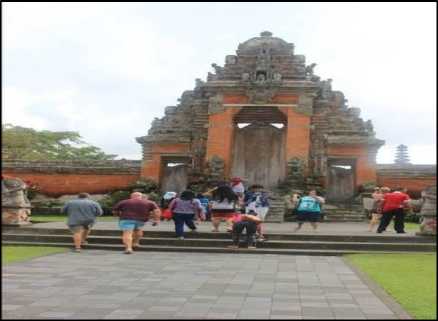
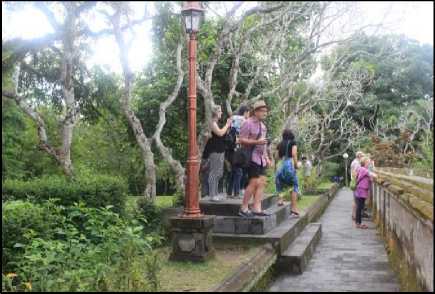
Figure 1. Tourists at Taman Ayun temple
As far as the religious aspect at Taman Ayun is concerened, tourists are allowed to visit the temple without wearing Balinese customes (figure 2). This phenomena can be said as a paradox. There is a regulation in Bali that tourists and tourist guides should be wearing traditional Balinese customes when they visit the temple. According to Picard (1996) this paradox can be assumed as “touristic culture”. The ideology behind this paradox must be commercialism.

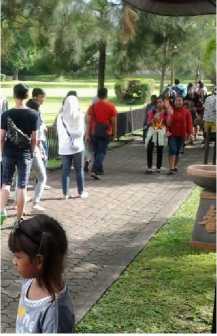
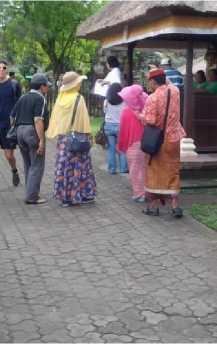
Figure 2. Tourists are not wearing Balinese custom visiting Taman Ayun temple
The social aspect (Pawongan) of Tri Hita Karana is the relationship between people and other people. Since Taman Ayun as a tourist destination, information and services to the visitors which represent human relation become critically important. Several signeds are available for the tourist guidance at the temple of Taman Ayun (figure 3). However, the booklet or a general information concerning the temple of Taman Ayun is in Indonesian language. There is no booklet or
information in English or other foreign languages are available in the front desk of the temple. This condition will make inconvenient for tourists who visit the temple by himself/herself without buying a package tour or unaccomponied by guide. In addition, there is no local guide available at the temple to provide information to the tourists.
soon as possible in order to gain sustainable tourism development at Taman Ayun. It seeems that no one is marginalized by the development of World Heritage management, especially the local community. The local community should get benefit from tourism development which is based on cultural hertiage.
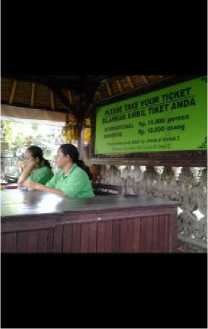
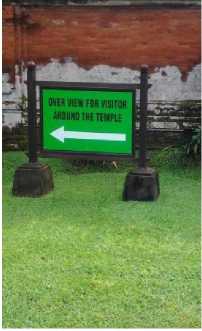
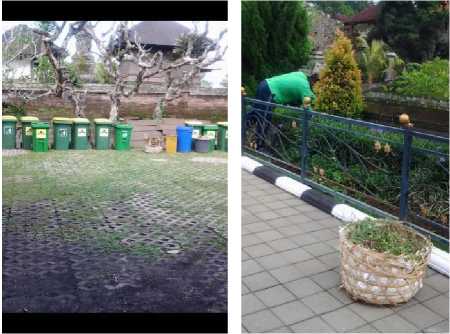
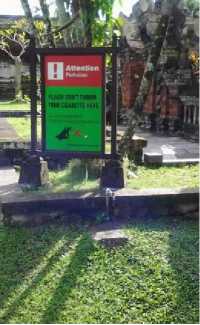
Figure 3. Signeds at Taman Ayun temple
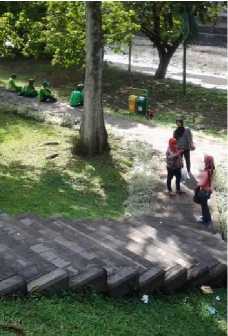
Figure 4. Rubbish bins and garderners at Taman Ayun Temple
In relation with the environment aspect or Palemahan of Tri Hita Karana, the gardens in the eastern and northern sides of the temple as well as the vendors in the front gate of the temple are well managed. Tourist buses are not allowed to park on the street in the front or in the south of the temple (figure 4). There are several cleaners and garderners work at Taman Ayun to keep green and clean of the temple. Toilets and wantilan (arena for cockfighting) have been restored after Taman Ayun determined as World Heritage site. In terms of the environment surrounding the Taman Ayun is well managed. However, several vendors are complaining for relocation program because buyers and tourists are difficult to get access to their location. This phenomena must be solved by the autority as
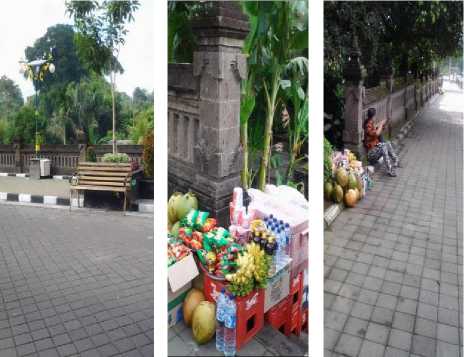
Figure 5. Street management in the front of the Taman Ayun and vendors along the pedestrian toward the temple
Tirta Empul Temple
The temple of Tirta Empul is also a tourist destination at Gianyar regency. In the last five years between 2010 and 2014, the number of tourists visited the temple can be seen in table 2 as follows.
Table 2. The number of tourists visited Tirta Empul temple
|
Years |
Foreign Tourists |
Domestic Tourists |
Total |
|
2014 |
285.617 |
158.267 |
443.884 |
|
2013 |
243.459 |
202.043 |
445.502 |
|
2012*) |
272.142 |
189.535 |
461.677 |
|
2011 |
188.787 |
177.591 |
366.378 |
|
2010 |
198.641 |
146.604 |
345.245 |
|
Source. |
Department |
of Tourism, |
Gianyar |
Regency
Tabel 2 indicates that the number of tourists visited the temple were fluctuating in the last five years between 2010 and 2014. The number of tourists visited Tirta Empul were declining after the site has been determined as World Heritage site.
Thirty respondents were determined accidentally during the survey at Tirta Empul, fifteen were foreigners and another fifteen were local tourists. There are four categories of respondents in terms of their ages namely: (1) 15-29 years, (2) 30-44 years, (3) 45-59 years, and (4) more than 60 years. Two respondents (13,33%) of foreign tourists in the category of 15-29 years. Six respondents (40%) which are 30-44 years old. Two respondents (13,33%) in the category of 45-59 years old, and five respondents (33,34%) in the category more than 60 years old. In terms of gender the foreign respondents consist of four men and eleven women. Their occupations include entrepreneurs, teachers, medical doctors, student, pensioners, and shop keepers. 73% of foreign tourists bought package tours to the temple or destination, (6,67%) knew the site through friend, 6,67% through book, and 13,33% through internet.
The domestic (local and national) respondents can be classified as follows: the category of 15-29 years old three respondents (20%), 30-44 years old six respondents (40%),
and 45-59 years six respondents (40%). No domestic respondent are older than 60 years old. Most foreign and domestic respondents do not understand that the temple has been determined as World Heritage site which is based on the philosophy of Tri Hita Karana. Unlike Taman Ayun, every tourist who visited Tirta Empul temple must wear Balinese customes. Sarong and scarf are provided for tourists at the entrance of the temple (see figure 6).
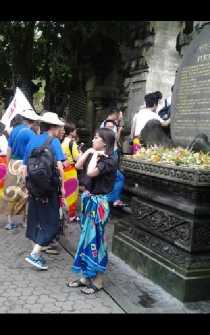
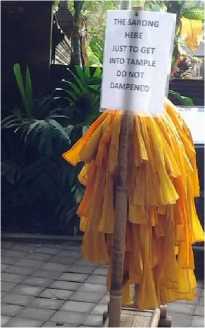
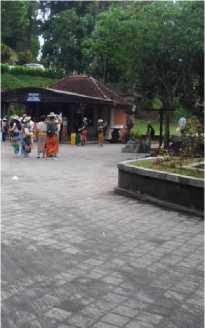
Figure 6. Sarung and scarf are provided at the entrance of Tirta Empul temple
Tourists who visit Tirta Empul must wear the Balinese customes in order to keep the holyness of the temple. However, tourists at Tirta Empul are allowed to enter the third yard or the most sacred part of the temple (see figure 7). This phenomena is totally different comparing to the situation at Taman Ayun where tourists are forbidden to enter the third yard of the temple itself. Only certain area of the inner yard or the third yard of the temple is restricted for the tourists at Tirta Empul temple (see figure 7). Picard (1996) states this paradox as touristification. There is exception for tourists who allow to enter in the most
sacred place of the temple. The idiology behind this phenomena might have been commercialization. It is the religious aspect of Tri Hita Karana that being practised at the Tirta Empul temple.

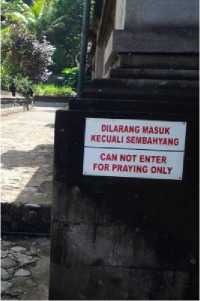
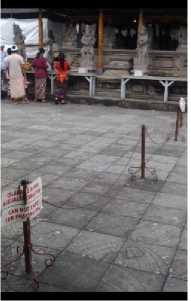
Figure 7. Tourists took photograp for themself and forbidden notice at the inner yard of Tirta Empul temple
The social aspect (Pawongan) of Tri Hita Karana at the temple of Tirta Empul were represented by providing services and informations to the tourists. As already noticed, sarong and scarf were provided to the tourists when they visit the temple. Signeds or information notices are also provided to the tourists. In addition, tourists who are willing to purify themselves at the holy springs of the temple are welcome (see figure 8). There is a myth that the holy springs were created by God of Indra to prevent his followers from the poison which were produced by king Mayadanawa. Not only the local people but also foreign tourists took part for melukat or purification ceremony. The tourists brought their offerings and wore the Balinese customes for this ceremony. This behavior represent “cultural tourists” namely tourists who respect and practice local tradition.
It should be noticed that tourists complaining the fees and condition of toilets and the places for changing clothes after they have had purification ceremony. The toilet fees seem too commercial for the tourists and the condition of the toilets is under international standar.
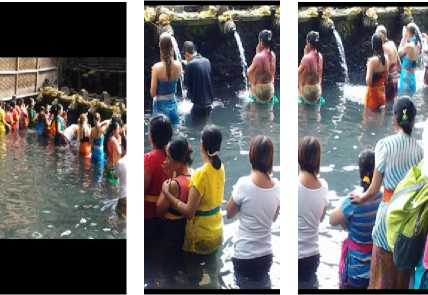
Figure 8. Tourists take ques and practice melukat or purification ceremony at Tirta Empul
The environment aspect (Palemahan) of Tri Hita Karana at the temple of Tirta Empul has been managed properly. Pedestarian were created that caused easier for visitors to observe the temple. The wantilan pavilion was restored and fish pond was maintained as additional tourist attraction (see fig. 9).

Figure 9. Pedestarian around the temple and the fish pond at Tirta Empul
Discussion
Taman Ayun and Tirta Empul have been determined as World Heritage sites. Cultural heritage is contested and negotiated in the interplay of local, national and global spaces (Yamashita, 2013). The phylosopy of Tri Hita Karana is the outstanding universal values or local wisdom of the Balinese people should be understood by national and foreign tourists. As already noted that the majority of national and foreign tourists have not understood yet the outstanding universal values of Tri Hita Karana. It seems that the tourism authority of the government of Bali and the managements of both Taman Ayun and Tirta Empul should promote the phylosopy of Tri Hita Karan to tourists and travel agents in order to increase the number of tourists visit those temples.
The number of tourists visited Taman Ayun and Tirta Empul after the temples have been determined as World heritage sites do not increase significantly (see table 1 and 2). Similar case also occurred at Borobudur. The number of foreign tourists visited Borobudur in 2014 was 250.000 person. The minister of Tourism of Indonesian government stated that Borobudur should gain 2 million tourists. The Angkor Wat temple was visited by 2.1 million foreign tourists in 2015 In comparison to the old city of Lijang in China the situation is quite different. According to the Tourism Board of Lijiang City, 1.06 million tourists visited the Old Town in 1996, one year before the world heritage designation, which rose to 4.33 million in 2007. In 2012 the number of visitor amounted to 16 million. Most of them are Chinese domestic tourists. In terms of tourism development, the Old Town seems quite successful, and the effects of world heritage considerable (Yamashita, 2013).
Many writers criticise the effects of world heritage designation from the viewpoint of Lijiang’s local community. They write, ‘Lijiang does not need world heritage.’ Through the increase in number of tourists, the river water, which had supported the live of the local people, is now polluted. Traditional houses in the Old Town have been transformed into souvenir shops, restaurants or guesthouses. The Naxi people who live in the Old Town have moved out, and Han Chinese
have moved in to run the shops. As of 2007, Naxi residents ran only 98 of 379 guesthouses in the Old Town, while 281 were run by non Naxi, mostly Han Chinese. In other word, that the Old Town of Lijiang today exists for the tourists rather than the Naxi (Yamashita, 2013).
It is interesting to note that the govenment of Bali developed Cultural Tourism policy. The cultural tourism which promotes the cultural identity of a local population as a tourist attraction (Picard, 2008). The impacts of tourism industry on Bali were understood as a threat of cultural pollution. To prevent such a fatal outcome, the Balinese authorities devised a policy of Cultural Tourism which was intended to develop tourism without debasing Balinese culture, by using culture to attract tourists while fostering culture through the revenue generated by tourism (Picard, 2008).
The use of Taman Ayun and Tirta Empul temples as tourist attractions in Bali have had some impacts on the religious, social, and environment aspects. There are restriction or limitation of access for tourists to visit Taman Ayun and Tirta Empul in order to keep the holyness of the temples. However, by allowing tourists without wearing Balines customes to enter the Taman Ayun temple, and tourists freely visit the inner yard of the Tirta Empul. This is known as touristification process. In other words, the sacredness of the temples of Taman Ayun and Tirta Empul appear to be declining due to tourism industry. This phenomena should be solved by negotiating and adopting local values by tourists in order to maintain the sacredness or religious aspect the temples.
(Yamashita, 2013) states that the central issue of world cultural heritage has given the interplay of local, national and global interests is who will make use of heritage site for whom, and for what purpose. The priority should be given to the local agents in cultural resources management. Cultural resources should be utilised primarily for local benefit, National and international agents should only be collaborators in the exploitation of cultural resources, not the main beneficiaries. It is clear that world heritage designations should be used primarily for the
benefit of the local communities where world heritage sites are located, contributing to their happiness (Yamashita, 2013). In relation to tourism industry, tourism was accussed of corrupting Balinese culture, desacralisation of temples and the profanation of religious ceremonies, the monetisation of social relations and the weakening of communal ties, or else the relaxing of moral standards and the rise of mercantile attitudes. The issue was about what could be presented and marketed to the tourists. In this case, culture was being designed as product (Picard, 2008).
As World heritage sites, Taman Ayun and Tirta Empul are no longer the exclusive property of the Balinese alone. Both temples become the main attraction for the tourists as brand image of tourist destination. According to Picard (Picard, 2008) culture or the Balinese temples had become for capital, which they could exploit for a profit. It seems that one could speak of ‘touristic culture’ once the Balinese came to confuse these two uses of their culture, when that by which the tourists identified them became that they identified themselves – that is, when the imperatives of the touristic promotion of their culture informed the considerations that their motivation will preserve it, to the extent that the Balinese ended up taking the branding image of their tourist product for the maker of their cultural identity.
Indeed as soon as a society offers itself for sale on a market, as soon as it attemps to enhance its appeal to the eyes of foreign visitors, then it is the very consiousness that society has of itself which is being effected. In this respect, the local people are not passive objects of the tourist gaze (Urry, 1990), but active subjects who construct representations of their culture to attract tourists (Picard, 2008).
Conclusion
The designation of World heritage sites of Taman Ayun and Tirta Empul has not significantly increase the number of tourists visiting the temples yet. The outstanding values of Tri Hita Karana namely harmony and balance between religious (Parhyangan), social (Pawongan), and environment (Palemahan) aspects should be promoted and maintained for the benefit of local people.
Contestation and negotiation in local, national, and international levels should be conducted toTaman Ayun and Tirta Empul as World heritage sites. Taman Ayun and Tirta Empul as cultural identity of the Balinese should be preserved and served as capital for the tourists. In this case, World heritage sites should give beneficial for the local and the tourists as well.
References
Ardika, I. W., Dhana, I. N. and Setiawan, I. K.
(2015) Implementasi Tri Hita Karana dalam Pengelolaan Warisan Budaya Dunia sebagai Daya Tarik Pariwisata di Bali. Denpasar. Universitas Udayana.
Chheang, V. (2011) ‘Angkor heritage tourism and tourist perceptions.’, Tourismos, 6(2).
Lansing, J. S. (2012) Guide to Bali’s Unesco World Heritage. Unesco.
Picard, M. (1996) Bali. Cultural tourism and touristic culture. Archipelago Press.
Picard, M. (2006) Bali: pariwisata budaya dan budaya pariwisata. Kepustakaan Populer Gramedia.
Picard, M. (2008) ‘Balinese identity as tourist attraction: Fromcultural
tourism’(pariwisata budaya) toBali
erect’(ajeg Bali)’, Tourist Studies.
Sage Publications Sage UK: London, England, 8(2), pp. 155–173.
Yamashita, S. (2013) ‘The Balinese Subak as World Cultural Heritage: In the Context of Tourism’, Jurnal Kajian Bali (Journal of Bali Studies), 3(2).
http://ojs.unud.ac.id/index.php/eot
93
e-ISSN: 2407-392X. p-ISSN: 2541-0857
Discussion and feedback